When it comes to flavor-packed condiments, peanut chutney (groundnut chutney) reigns supreme. This versatile and delectable accompaniment has long been a staple in many South Indian households, bringing a burst of flavor and a delightful nuttiness to a wide array of dishes from dosas and idlis to sandwiches and wraps and deserves a special place in your culinary repertoire!

What is peanut chutney?
Peanut chutney, also known as "groundnut chutney," has its roots in South Indian cuisine, particularly in the states of Andhra Pradesh and Tamil Nadu. The process of making peanut chutney involves roasting the peanuts to enhance their flavor, then grinding them with a blend of spices and tangy tamarind. The result is a creamy, slightly chunky chutney.
Peanut chutney has a nutty, spicy, and tangy flavor profile. It adds depth and character to a wide variety of meals, making it a must-have condiment. Its rich, nutty flavor combined with a hint of spiciness makes it an ideal accompaniment to a variety of dishes, from traditional Indian breakfast staples like idli, dosa, and upma to snacks like pakoras and samosas. Peanut chutney is also a perfect companion for rice dishes such as pulao and biryani, as well as a tasty addition to sandwiches and wraps. The nutty and spicy notes of the chutney can even elevate the simplest of meals, turning them into a culinary delight. Whether you're a fan of traditional Indian cuisine or simply looking to elevate your everyday meals, peanut chutney is a versatile delight that deserves a place on your table.
Aside from its incredible taste, peanut chutney also offers numerous health benefits. Peanuts are a rich source of protein, healthy fats, and dietary fiber, making this chutney an excellent choice for those following a vegetarian or vegan diet. The presence of essential nutrients like vitamin E, niacin, and folate in peanuts further contributes to its nutritional value.
Jump to:
Ingredients

- Oil: Use any neutral flavored oil. Avocado oil is my favorite to use for Indian cooking.
- Tempering spices - mustard seeds, cumin seeds, dried red chilies, curry leaves
- Peanuts. I like using raw peanuts with their skin on for the best flavor. You could also use pre-roasted peanuts in this recipe
- Ginger and spicy green chilies (Thai green peppers) for flavor and heat.
- Tamarind paste for tanginess.
- Cumin seeds add a lovely earthy flavor to the chutney.
- Jaggery to balance all the flavors and add a touch of sweetness.
How to make peanut chutney

- Heat 1 teaspoon oil in a frying pan on medium heat. Add in the raw peanuts and stir fry them for about 2-3 minutes or until lightly golden brown and crispy. Take the pan off the heat and let the peanuts cool down to room temperature.
- Add all the ingredients for the chutney into a blender.
- Blend well until you get a smooth chutney.
- Heat the oil in a pan on medium heat for tempering the chutney. When it is hot, add in the mustard seeds and let them pop. When they pop, add in the cumin seeds, dried red chili and curry leaves and turn off the heat. Stir this mixture and let it toast for about a minute. Pour this mixture over the chutney. Mix everything well before digging in.

Tips and tricks
- Choose high-quality peanuts: fresh, high-quality peanuts will impart better flavor to your chutney. You can use either raw or roasted peanuts, depending on your preference. Roasting the peanuts before making the chutney adds a deeper, nuttier flavor.
- Roast the peanuts well: If you're using raw peanuts, roast them until they turn a golden brown color. This process not only enhances the taste but also helps remove any excess moisture from the peanuts, resulting in a smoother texture.
- Adjust spice levels: Adjust the amount of chilies according to your spice preference. For a milder chutney, remove the seeds from the chilies before adding them. If you prefer a spicier kick, leave the seeds in or add a touch of chili powder.
- Balance the flavors: Achieve a well-balanced flavor by adding tanginess sweetness to the chutney. Tamarind pulp and jaggery help bring balance to the otherwise savory flavors in this chutney.
- Experiment with additional ingredients: While the basic peanut chutney recipe is fantastic on its own, feel free to experiment with other ingredients. Additions like grated coconut, roasted garlic, ginger, or fresh herbs like coriander or mint can bring unique flavors and textures to your chutney.
- Adjust consistency: The consistency of peanut chutney can vary depending on personal preference. If you prefer a thicker chutney, use less water while blending. For a thinner consistency, gradually add water until you achieve the desired thickness.
- Taste and adjust: Always taste the chutney before serving and adjust the seasoning accordingly. Add more salt, spices, or tanginess if needed. Don't hesitate to customize the chutney to suit your palate.
- Allow flavors to meld: Let the chutney sit for at least 10-15 minutes before serving. This allows the flavors to blend together, resulting in a more harmonious taste.

Substitutions
Peanut chutney is naturally vegan and gluten free.
If you're looking for substitutions for peanut chutney due to allergies, personal preferences, or dietary restrictions, here are a few alternatives you can try:
- Almond Chutney: Replace peanuts with almonds to create a delicious almond chutney. Follow a similar recipe to peanut chutney, using roasted almonds, spices, herbs, and other flavorings. Almond chutney will have a slightly different taste but offers a similar nutty richness.
- Cashew Chutney: Another nutty alternative is cashew chutney. Replace peanuts with roasted cashews to create a creamy and rich chutney. Cashews provide a buttery flavor and smooth texture, making it a delightful substitution.
- Sunflower Seed Chutney: For those with nut allergies, sunflower seed chutney can be a great option. Replace peanuts with roasted sunflower seeds to achieve a similar texture and nuttiness. Sunflower seeds have a mild, nutty flavor and are packed with nutrients.
- Sesame Seed Chutney: Sesame seed chutney, also known as til chutney, is a flavorful alternative. Toasted sesame seeds combined with spices and other ingredients create a delightful chutney with a unique taste. This option works well for those with nut allergies or anyone seeking a different flavor profile.
- Roasted Chickpea Chutney: If you're looking for a protein-packed option, roasted chickpea chutney can be a great choice. Roast chickpeas until crispy and blend them with spices, herbs, and other ingredients to create a delicious and wholesome chutney.
- Tomato Chutney: If you prefer a tangy and vibrant chutney, tomato chutney is an excellent substitution. It uses tomatoes as the base ingredient, combined with spices, herbs, and seasonings to create a flavorful condiment.
- Roasted Red Pepper Chutney: For a different flavor profile, roasted red peppers can be used as a base ingredient. Roast red bell peppers, remove the skin, and blend them with spices, herbs, and tangy ingredients to create a flavorful chutney.
- Coconut Chutney: Coconut chutney is a classic South Indian accompaniment that can be enjoyed on its own or as a substitute for peanut chutney. Made with fresh grated coconut, it offers a creamy texture and a mildly sweet flavor that pairs well with a variety of dishes.
Remember to adjust the seasoning and spices based on your chosen substitution to achieve the desired taste profile. Feel free to experiment with these alternatives and tailor them to your own preferences.
Check out this egg puffs recipe, if you like South Indian flavors!
Pairing
Peanut chutney can be enjoyed with almost anything, from traditional Indian breakfast staples like idli, dosa, and upma to snacks like pakoras and samosas. Peanut chutney is also a perfect companion for rice dishes such as pulao and biryani, as well as a tasty addition to sandwiches and wraps.
My favorite pairing with this peanut chutney is rava idli! Definitely try out my rava idli recipe, you will love the combination.

Equipment
A good blender makes it very easy and quick to blend this peanut chutney. I swear by my Vitamix blender. The small jars make it very easy to blend up a small batch of spices for this recipe.
I like using this pan or skillet to make the tempering(tadka) and roast the peanuts. It should be wide enough to allow even roasting of the peanuts.
Storage
Peanut chutney can be stored in an airtight container in the refrigerator for up to a week. Before serving, give it a stir and adjust the consistency if needed by adding a little water.
I also love to make a large batch of the chutney and freeze it in small containers or ice cube trays. Thaw the chutney in the refrigerator overnight or in the microwave for a few seconds before serving.
Frequently asked questions
Is peanut chutney good for you?
Peanuts are a plant-based source of protein, making peanut chutney an excellent option for vegetarians and vegans looking to increase their protein intake. Peanuts contain predominantly monounsaturated and polyunsaturated fats, which are considered heart-healthy fats. These fats help maintain healthy cholesterol levels, reduce the risk of heart disease, and support brain health.
However, it's important to note that peanut chutney should be consumed in moderation due to its calorie density. Peanuts are relatively high in calories, so it's advisable to watch portion sizes, especially if you are following a calorie-restricted diet or trying to lose weight. Additionally, if you have a peanut allergy or sensitivity, it's crucial to avoid peanut chutney and seek alternative options that suit your dietary needs.
Related
I hope you love this recipe as much as I do! If you try this recipe, please leave a star rating on the recipe card and leave a comment below to let me know what you think. Subscribe to my newsletter for more easy and delicious recipes!
Recipe
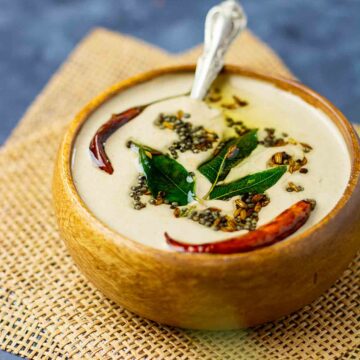
Peanut chutney | Groundnut chutney
Equipment
Ingredients
For the chutney
- ½ cup peanuts
- ¾ cup water
- 3 large spicy green chilies (Thai green peppers)
- 1 teaspoon ginger root
- ½ teaspoon tamarind paste
- 1 teaspoon jaggery powder or brown sugar
- ¼ teaspoon cumin seeds
- salt to taste
For the tempering
- 1 tablespoon avocado oil (or any flavorless oil of your choice)
- ¼ teaspoon mustard seeds
- ¼ teaspoon cumin seeds
- 1 dried red chili
- 5 curry leaves
Instructions
- Heat 1 teaspoon oil in a frying pan on medium heat. Add in the raw peanuts and stir fry them for about 2-3 minutes or until lightly golden brown and crispy. Take the pan off the heat and let the peanuts cool down to room temperature.
- Add the roasted peanuts along with all the other ingredients for the chutney into a blender and blend well until you get a smooth chutney.
- Heat the oil in a pan on medium heat for tempering the chutney. When it is hot, add in the mustard seeds and let them pop. When they pop, add in the cumin seeds, dried red chili and curry leaves and turn off the heat. Stir this mixture and let it toast for about a minute before pouring this mixture over the chutney.
Notes
Estimated Nutrition
Food safety
- Don't leave food sitting out at room temperature for extended periods
- Never leave cooking food unattended
- Use oils with high smoking point to avoid harmful compounds. My favorite oil for all high heat cooking is avocado oil.
- Always have good ventilation when using a gas stove
See more guidelines at USDA.gov.


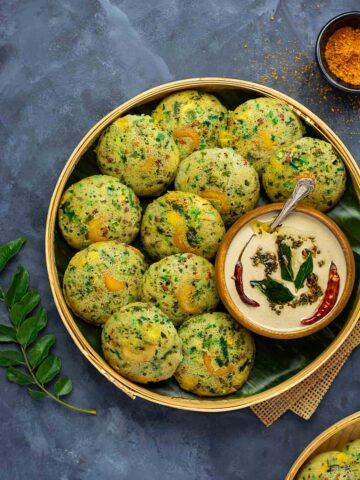
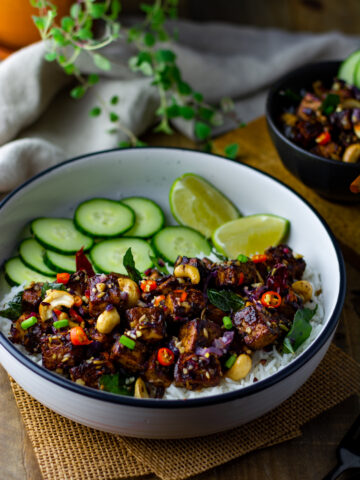
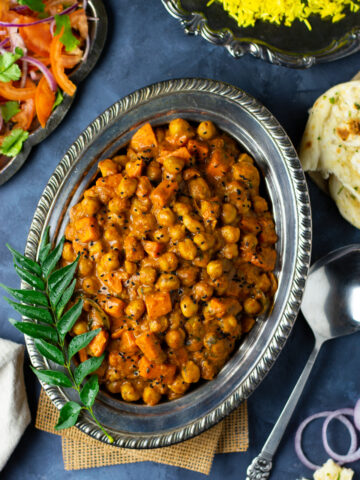



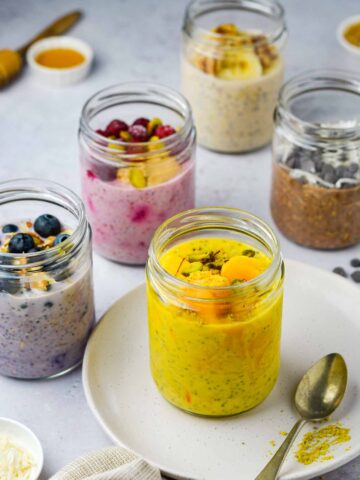

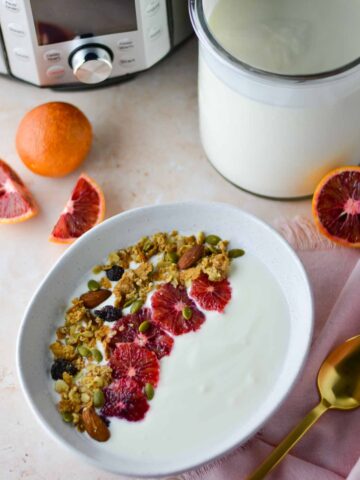
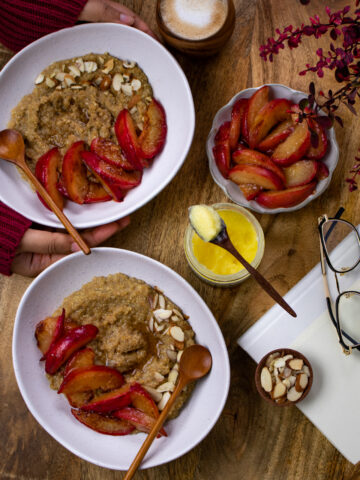
Leave a Reply